#Villa dei MIsteri
Explore tagged Tumblr posts
Text
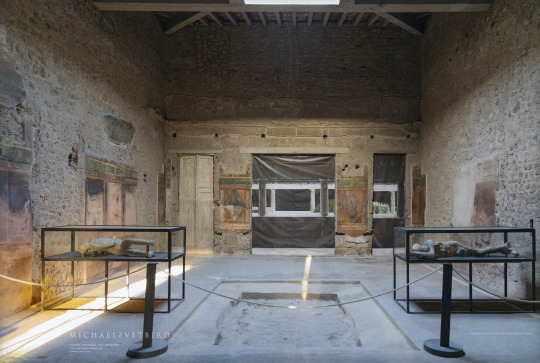
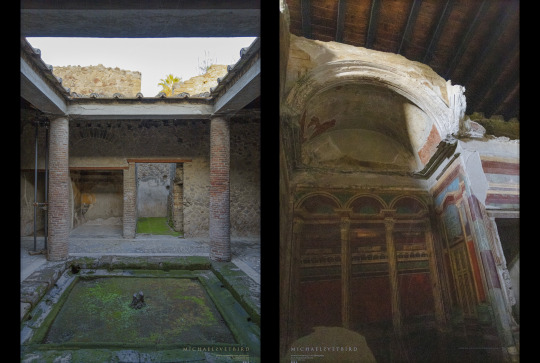
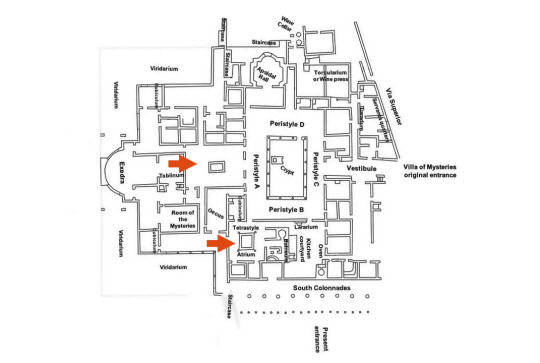
ATRIUMS | Villa dei Misteri | Villa of the Mysteries: Pompei Scavi, Pompeii, Regio VI. http://pompeiisites.org/en/archaeological-site/villa-of-the-mysteries
Parco Archeologico di Pompei | PAP Web : http://pompeiisites.org/en FB : https://www.facebook.com/pompeiiparcoarcheologico IG : @pompeii_parco_archeologico TW : @pompeii_sites
PAP | Michael Svetbird phs©msp | 10-11|2022 6100X4100|6200X4100 [non commercial use | sorry for the watermarks]
.
#pompeii#pompei#pompéi#pompeiscavi#scavi#archaeologicalpark#parcoarcheologico#archaeological site#villa of the mysteries#villa dei misteri#villa#romanvilla#bay of naples#ancient pompeii#pompeii ruins#ancient architecture#architectonic#archaeology#archeologia#ancient history#excavations#antiquity#heritage#ancient#museology#ancientcivilization#photography#museum photography#archaeologyphotography#michaelsvetbird
11 notes
·
View notes
Text
ARCHEOLOGIA / Full immersion nella storia: ecco la "Grande Pompei", un parco diffuso per visitare la città vesuviana, Boscoreale, Oplontis e Stabia
Tutte le aree archeologiche saranno collegate con una navetta gratuita e visitabili con un unico biglietto valido 3 giorni. Riaprono anche le ville di Stabia e l'Antiquarium di Boscoreale.
Tutte le aree archeologiche saranno collegate con una navetta gratuita e visitabili con un unico biglietto valido 3 giorni. Riaprono anche le ville di Stabia e l’Antiquarium di Boscoreale. Ed eccola, finalmente, la Grande Pompei. Un parco diffuso di cui fanno parte le aree archeologiche di Pompei, Boscoreale, Oplontis e Stabia e tutto il territorio circostante. Un unico biglietto, valido per…
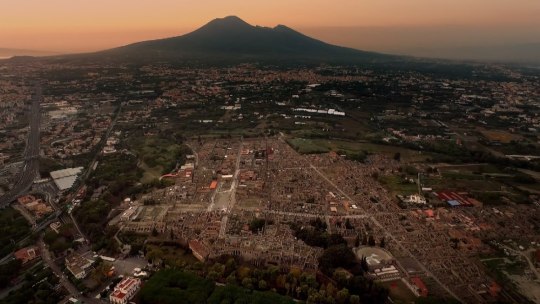
View On WordPress
#archeologia#Boscoreale#Campania#carro di Civita Giuliana#Civita Giuliana#Grande Pompei#Grande Progetto Pompei#notizie#Oplontis#Parco Archeologico di Pompei#pompei#scavi#scavi archeologici#Scavi di Pompei#Stabia#Villa dei Misteri
0 notes
Text
In the serie Daniel should shine as the iconic main character material that he is, because from what I understand he was pushed to the sidelines in later books but honey...
Devil's minion spoliers:
He was turned inside the fucking Villa dei Misteri in Pompeii, heavily guarded archeological site in which he used to wander at night whenever he pleased, had this Grand Tour sort of travel to enjoy art and literature while he got high and battled with his will to live because he's a tortured poet, he had a Vampire boyfriend that could get freaky or incredibly silly, who gave him his blood to protect him and bought him an island- oh, and he was tall, skinny, with ashen hair and violet eyes.
What in the Mary Sue, My Immortal Ebony Dark'ness Dementia Raven Way is this??
#daniel molloy#he is and will always be iconic#interview with the vampire#iwtv#the devil's minion#it's giving princess#lestat was turned in a fucking dungeon and Daniel in a ✨ancient Roman Villa✨#very demure
33 notes
·
View notes
Text
Part 11 of Caldera; 7 of 7 chapters now posted. This story has a bit of everything: Daniel's and Armand's unlikely little coven stubbornly hanging onto human holiday traditions, taking a trip to Europe, finding Sam and Rashid by sheer dumb luck, running into some genuinely deadly circumstances on the penultimate stop of their trip, and revisiting a place of romantic significance on their final stop.
New York (2024-08-31)
Night Island (2024-08-31)
Atlantic Crossing (2024-09-02)
Rive Gauche (2024-09-04)
Rive Droite (2024-09-05)
Camden Town (2024-09-05)
Villa dei Misteri (2024-09-07)
TEASER:
The scene that awaits [Daniel and Sam] is chaos. There are three piles of grease and ash on the ground amidst the dust and broken glass, and Armand—
Armand, his face covered in blood and blackened gore, his eyes lava-bright with mindless fury, is locked in hand-to-hand combat with a vampire who has at least several inches in height and two hundred pounds in weight on him. There must be some reason he hasn’t incinerated this fucker. Maybe this is the one that has harmed the fledglings such that they’ve ended up covered in blood. Fire would be a fate too kind.
Daniel acts on sheer instinct, sending a blast of psychic interference. Hey, over here!
Snarling, Armand finds enough of an opening to rip out the other vampire’s throat.
#devil's minion#armand x daniel#armandaniel#devils minion#armand#daniel molloy#the vampire sam#real rashid#iwtv#iwtv s2#iwtv fanfiction#iwtv fanfic#iwtv fic#interview with the vampire
13 notes
·
View notes
Text
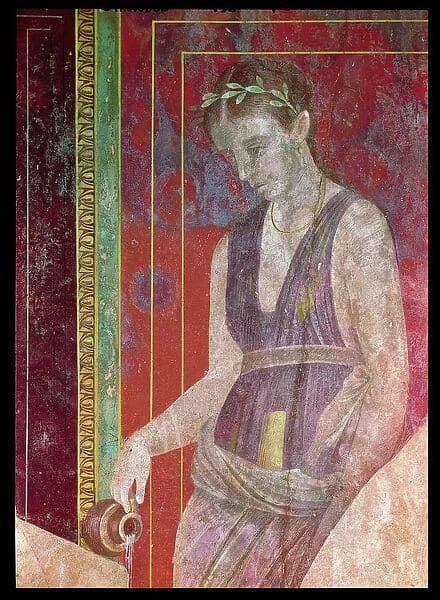
Fresco showing a Dionysian initiation ritual in the Villa dei Misteri, North Wall, Oecus 5 / detail, Pompeii (60-50 BCE) :: [Robert Scott Horton]
* * * * *
“It's a very Greek idea, and a very profound one. Beauty is terror. Whatever we call beautiful, we quiver before it. And what could be more terrifying and beautiful, to souls like the Greeks or our own, than to lose control completely? To throw off the chains of being for an instant, to shatter the accident of our mortal selves? Euripides speaks of the Maenads: head thrown I back, throat to the stars, "more like deer than human being." To be absolutely free! One is quite capable, of course, of working out these destructive passions in more vulgar and less efficient ways. But how glorious to release them in a single burst! To sing, to scream, to dance barefoot in the woods in the dead of night, with no more awareness of mortality than an animal! These are powerful mysteries. The bellowing of bulls. Springs of honey bubbling from the ground. If we are strong enough in our souls we can rip away the veil and look that naked, terrible beauty right in the face; let God consume us, devour us, unstring our bones. Then spit us out reborn.” ― Donna Tartt, The Secret History
#fresco#Dionysian initiation ritual#Pompeii#Robert Scott Horton#quotes#Donna Tartt#The Secret History
34 notes
·
View notes
Text
Notes on "Ambidextrous Angle" here
Notes on "Lady Justice" here
Notes on the flowers in ep.8 here
Notes on the numbers on the car plate of No.3 and KMC here
The Colors in ep. 10
During the torture scene of LMS they went through multiple types of colors, which I found pretty interesting as someone whos studied colors and their meanings intensely over the years. And as a lot in TKV has meaning and thoughts put behind it, I wanted to make a post highlighting the scene- and the colors specifically. It will also including short historical informations about each color.
Its starts with a mix of red and orange on the tables- making it look like vermillion (a color that borders orange and red and is also often times used in skin color shading), specifically HEX color FFD400. The color will come up later again.

Interestingly enough, since ancient times the color vermillion was regarded as the color of blood- thus of life. In Ancient Rome, the color was widely used to paint frescos, to decorate statues and produce cosmetics. It was also used in the Byzantine Empire reserved for the use of the imperial family and their administrators (used in official letters and imperial decrees) the illuminated manuscripts of the Middle Ages, in the paintings of the Renaissance, as well as in the art and lacquerware of China. The color can also be found all over the murals in Villa dei Misteri (Villa of Mystery before 79 AD) in Pompeii.
As the color of blood and life, it fits perfectly as the starting color of the whole scene.
LMS in the meantime is illuminated by white light.
Ironically- or fitting?- its the color of innocence, purity, hope and clarity. It represents goodness, perfection and peace. Looking at the color, it purifies the mind and helps to find balance. But like every color, it also has negative aspects such as coldness, emptiness, nothingness and distance. A lot of times, its also the color of self-reflection (VERY fitting if you’d ask me). White was one of the first colors used in Prehistoric cave art (good example are those at Lascaux in France) which feature marks and images made used calcite and chalk. Ancient Greece saw white as a sacred color (representing light and motherhood), in Rome plain white togas (togas virilis) were worn by all citizens at ceremonial occasions. During early christian times, they adopted the romans use of white- priests wore the color during mass as for them, white was symbolic of purity, humility and virtue (reinforced by the “white lamb” which was symbolic of christ’s sacrifice for humanity). Later, throughout the middle ages, white was strongly associated with martyrdom. It was also the commonly worn color by widows in mourning up until the 16th century- giving the color an association with death and refelection.
Illuminating a criminal like him in white is truly a choice. It does fit the intentions of the whole torture tho: redeption, hope and clarity.
In the same frame, centering the vermillion color, we can also see yellow and orange.
Yellow is the color of happiness and optimism. It clarifies and inspires the mind and helps in creativity- it also gives warmth. The negative associations with the color are caution, egotism, deception and cowardice. Yellow is also one of the oldest colors to exist and is seen in cave paintings 17.000 years old. Painters in the Middle Ages and Renaissance used “Indian yellow” to show an outsider. Most notably Judas Iscariot (again, pretty fitting to the whole biblical references found throughout TKV). In ancient religions, yellow was a sacred color. Just like gold, it was seen as eternal, imperishable and indestructible. Many religions worshipped the sun, and the sun gods were depicted wearing yellow. The Ancient Egyptians believed the gods had gold skin and bones and used yellow for their skin tone in art. Yellow is also an important color in Buddhism, signifying humility. It can also be found in paintings from Ancient Rome.
Orange symbolizes youth, enthusiasm and optimism. It uplifts and stimulates the mind. Its the color of creativity, warmth and spontaneity. On the other hand, it shows domination and impatience. Up until the 16th century it was called “saffron” or “yellow-red”. When Portuguese merchants brought orange trees to Europe from Asia in the late 15th and early 16th centuries, the citrus fruit’s name was adopted for the general color. In some cultures, orange is regard as a sacred color because it balances red’s power and yellow’s perfection. Monks and holy men in some Asian religions, like Buddhism, wear orange robes because that dye has been readily available historically. Buddhists also connect orange to the highest state of illumination. Its also the color of transformation in Confucianism. and a symbol of royalty.
Again, two colors highlighting the personalties of both LMS and KSJ in a well done way.
The color then changes to a dirty blue hue- with a slight turquoise shade.
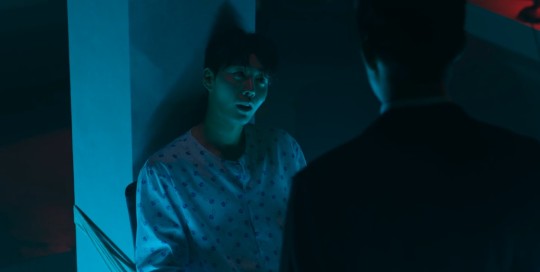
Blue- the color of loyalty and trust. It gives the feeling of security, trust, confidence, peace, honesty and reliability. It calms and relaxes the brain. Negative feelings associated with blue are passiveness, depression and prediction. The history of the color blue is quite interesting: It was never a color to be found in nature (no, water isnt blue and the sky also changes colors and if there is indeed something blue found in nature its either with a violet or turquoise shade) thus, we humans previously were never able to even “see” the color (we perceived it, but we had no idea what it even was). The first society to have a word for the colour blue was the Egyptians, the only culture that could produce blue dyes at around 2.200 B.C: They loved the precious stones lapis and turquoise* so much that they invented the first synthetic blue pigment in order to affordably copy their unique color. “Egyptian blue” was made by mixing silica, lime, copper, and alkali, and it could be used on stone, wood, plaster, papyrus and canvas.
Turquoise on the other hand is the color of compassion, calmness and clarity. It balances and stabilizes the brain. It can help concentrate, to grow, and underline empathy. In contradiction it also symbolizes narcissism, stress and secrecy. The earliest evidence of turquoise* gemstones comes from Ancient Egyptian tombs: They contain elaborate turquoise jewelry dating back to 3000 BCE. Egyptians set turquoise in gold necklaces as well as in rings, used it as inlay, and carved it into scarabs. Most notably, King Tut’s iconic burial mask was extravagantly adorned with turquoise. The oldest turquoise mines are in the Sinai Peninsula of Egypt. One sat near an ancient temple dedicated to Hathor, the Greek goddess of love and joy who was worshiped as a protector in the desert and as the patron saint of mining. Egyptians called turquoise “mefkat”, which meant “joy” and “delight.” -> Ancient Persians also decorated extensively with turquoise, often engraving it with Arabic script. Turquoise covered palace domes: For them, its sky-blue color represented heaven. (This later inspired the use of turquoise in buildings like the Taj Mahal). They also adorned their daggers and horses’ bridles with it as they believed it granted protection. They would also wear turquoise gemstone jewelry around their necks and in their turbans. -> Meanwhile, pre-Columbian Native Americans mined the turquoise stone throughout the present-day southwestern United States. Shamans used it in sacred ceremonies to commune with the spirit of the sky. -> Apache Indians believed that attaching turquoise to bows (and later, firearms) improved a hunter’s accuracy. -> Turquoise became valuable in Native American trade, which carried North American material toward South America. -> Consequently, Aztecs cherished turquoise for its protective power and used it on ceremonial masks, knives, and shields.
Picking the color blue is again a really nice callback to the OST. PT3 (Blue by Aalia) and highlights the depression (or "death") KSJ went through.
Turquoise shining onto LMS face fits perfectly. The negative aspects highlight his persona.
After the blue, the color switches to green and here it is when it gets really interesting- this might be an even longer historical excurse than the turquoise one:
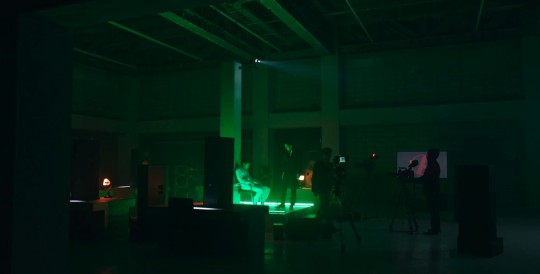
First we should start by looking at the positive associations to the color: It means harmony, safety, growth, health, hope, prosperity and luck. It helps the brain to revitalize, to relax and encourages. Negative aspects associated with the color are judgment, materialism and inexperience. And obviously the most famous ones: Envy and jealousy. We all know the famous saying “Green with envy” The history of the color green dates back to the Ancient Egyptians. To produce the color they used green earth and malachite, while the Ancient Greeks used verdigris. -> Malachite contains a high percentage of copper which makes it highly poisonous to humans when inhaling the dust or eaten. Once its polished its not poisonous anymore. -> Verdigirs is a common name for any variety of poisonous copper salts and acetic acids. Green had a resurgence in art during the Impressionist movement due to advancements in green pigments and paints.
The bold emerald green became popular in fashion in the 1800s, used for gloves and dresses- as well as wallpapers and furniture as well as found in candy, paper, toys, medicine and dye- it was also then it became an even more poisonous color. Its name varies from “Scheele's Green”, “Paris Green” to “Emerald Green” and “Schweinfurt Green”. And as it was probably already obvious, the color was loaded with copper arsenite which is one of the deadliest elements to have ever been found. Scheele’s green (invented around the 1775 by the Swedish chemist Carl Wilhelm Scheele) was an artificial colorant that was made by heating up sodium carbonate, adding arsenious oxide, and stirring until the mixture was dissolved. Copper sulfate was then added as the final ingredient which ends up giving it its vibrant green color ->(Arsenic is a highly toxic substance that causes skin lesions, vomiting, diarrhea, and in some cases, cancer) As said as it was quite popular in the 1800’s countries were riddled in this substance. ->(It has also been rumored to have killed the famous Napoleon Bonaparte.) Schweinfurt green is the product of combining copper acetate with arsenic trioxide, producing copper acetoarsenite. The toxic pigment was commercially developed in 1814 by the Wilhelm Dye and White Lead Company in Schweinfurt, Germany. It too was used everywhere, from clothing and wallpaper to colorant for fake flowers and paint.
By 1860 more than 700 tons of the pigment had been produced in the country alone.
There are stories of factory workers, mainly those who worked with fashion, suffering acid burning and losing their hair and limbs, specifically their hands, after they had been in contact with the color for way too long. “In 1871, a lady who purchased a box of green-colored gloves at a well-known and respectable house was horrified to find that her hands broke out in blisters after putting them on. Unless the dye was sealed, sweaty palms could cause the dye to run onto the wearer’s skin. Other accounts from this era tell of babies dying in their nurseries after playing on green carpets or rubbing up against green wallpaper. One foreign dignitary even told Queen Victoria that the green wallpaper in Buckingham Palace had made him ill.” On November 20, 1861, Matilda Scheurer, a 19-year-old artificial flower maker, died of “accidental” poisoning: The formerly healthy, “good-looking” young woman worked for Mr. Bergeron in central London, along with a hundred other employees. She “fluffed” artificial leaves, dusting them with an attractive green powder that she inhaled with every breath and ate off her hands at each meal. The brilliant hue of this green pigment, which was used to colour dresses and hair ornaments, was achieved by mixing copper and highly toxic arsenic trioxide or “white arsenic” as it was known. The press described her death in grisly detail, and by all accounts, Scheurer’s final illness was horrible. She vomited green waters; the whites of her eyes had turned green, and she told her doctor that “everything she looked at was green.” In her final hours, she had convulsions every few minutes until she died, with “an expression of great anxiety” and foaming at the mouth, nose and eyes. An autopsy confirmed that her fingernails had turned a very pronounced green and the arsenic had reached her stomach, liver, and lungs.
-> More on “Scheele’s Green” here
Green so not only fits the scene in relation to envy and jealousy, but also to its poisonous attributions. It again highlights KSJ previous personality (harmony) and LMS' (envy)- and the horrible deathly history behind the color makes it even more clear what type of person he is.
After the green, the room is then engulfed in yellow as well as vermillion (explained above) again-
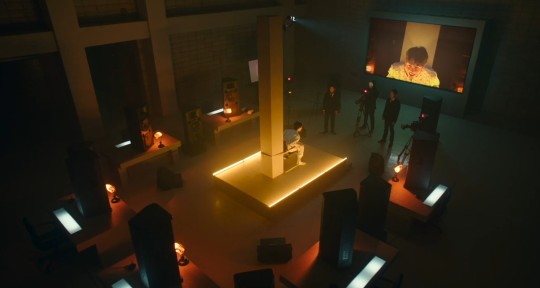
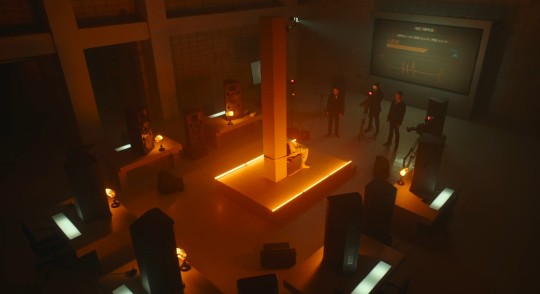
Following this, the last change of color we see is red.

Associated with action, strength, energy and passion red helps to stimulate and motivate the mind, to pay attention and stay cautious. Its positive aspects are courage, desire, sexuality and confidence whereas its negative associations are anger, danger, revenge and aggression. Throughout history, the color red has represented many things: life force, the divine to love, lust, and anger. Throughout the Middle Ages, red was a color of privilege in the Western world. For many cultures, it was the only color worthy enough to be used for social purposes (“In some languages, the word for red was the same as the word for color”). One of the first color developed for painting and dying, red became associated with war, wealth, and power in antiquity. In the Middle Ages, red had a religious significance, as it was seen as the color of the blood of Christ and the fires of Hell. It also had a secular meaning: The symbolism of love, glory, and beauty. During the Protestant Reformation, red began to decline in status and fell out of favor: It was viewed as indecent and immoral as it was linked to luxury and the excesses of the Catholic Church. After the French Revolution, red gained new respect as the color of progressive movements, freedom, new liberties and radical left-wing politics.
Personally, I love how they not only picked red as the last color to highlight the anger and pain of KSJ but also how it illuminates both him and KMC in a different shade. While KSJ has the more darker red, underlining the more calmer anger, KMC is drowned in bright hot red- underlining his anger which he definitely does NOT have under control (hes holding back so much in that scene and if it wasnt for the death penalty awaiting KSJ if LMS would die, he would have killed him without hesitation). Also, the religious importance is another nice callback to all the religious imagery we have seen throughout the drama.

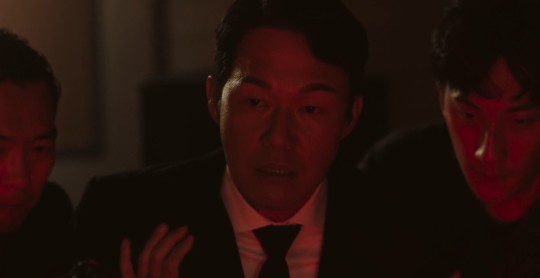
(might also add my delusions to the post: the red symbolizes the love they still feel for each other)
Intentionally or not, the way and order how they picked and presented the colors directly mirrors each character, their personal journey and the development of their anger. The fact it started with more calmer/friendlier colors and slowly turned into more agressive ones is done just beautifully.
24 notes
·
View notes
Text
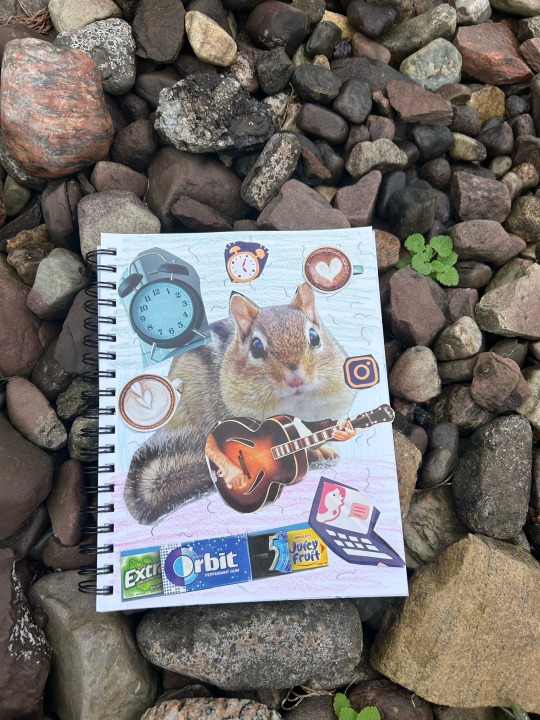
Animal facts:
Chipmunks are a part of the squirrel family and actually split off from rats and mice close to 70 million years ago. Source: A-Z Animals
Chipmunks need around 15 hours of sleep per day. Source: Treehugger
One chipmunk can gather up to 165 acorns in one day. Source: National Geographic
In just two days, a chipmunk can gather enough food to last an entire winter. Source: National Geographic
Wild chipmunks, on average, live two to three years; captive specimen have lasted 8 years. Source: National Wildlife Federation
Consumerist and technological facts:
Alarm clock fact: The Ancient Greek philosopher Plato used an early form of alarm clock known as a water clock in the 4th century BC to wake up on time. Source: Atlas Obscura
Gum fact: Iran has the highest chewing gum consumption in the world. This is because packets of chewing gum tend to be given out when shopkeepers do not have enough change. Source: Oh My Gum
Latte fact: A man named David Schomer started the US latte art craze in the mid 1980s. There are now latte art competitions where you could even see 3D latte art. Source: TheKitchn
Social media fact: Instagram was originally supposed to be called Codename but the name was changed before its launch. Source: The Enterprise World
Guitar fact: The first guitar was invented in Ancient Egypt and was made from Cleaned Cedar and rawhide soundboard. Source: Breakthrough Guitar
Attendance prompt:
"In April 1909, when it seemed as if Pompeii might have disgorged most of its secrets, archeologists discovered a luxurious home with large windows, overlooking the sea. Within a week of the first excavation, a red mural was uncovered that was so well conserved, elaborate, and unfathomable that ever since the site has been known as the Villa dei Misteri- "Villa of Mysteries." (Pg 144, The Secret Lives of Color"
This passage was very interesting to me and I did not know that there was a preserved red wall in Pompeii. I have actually visited Pompeii and was amazed by everything I saw there. I did not see this red wall but it is so crazy to think that the color could last through all the years and ash. I looked up images of the mural and it was amazingly beautiful. The red is such a distinct color and I can't imagine any other color being preserved as well as it. It is also so interesting that we are constantly discovering new archeological findings, even from things that happened thousands of years ago.
4 notes
·
View notes
Photo

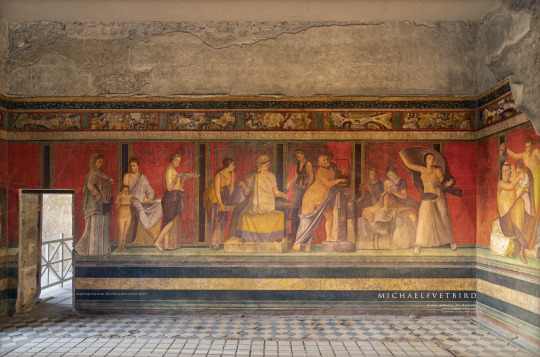
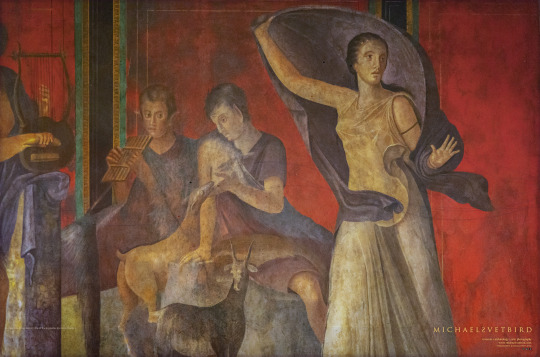

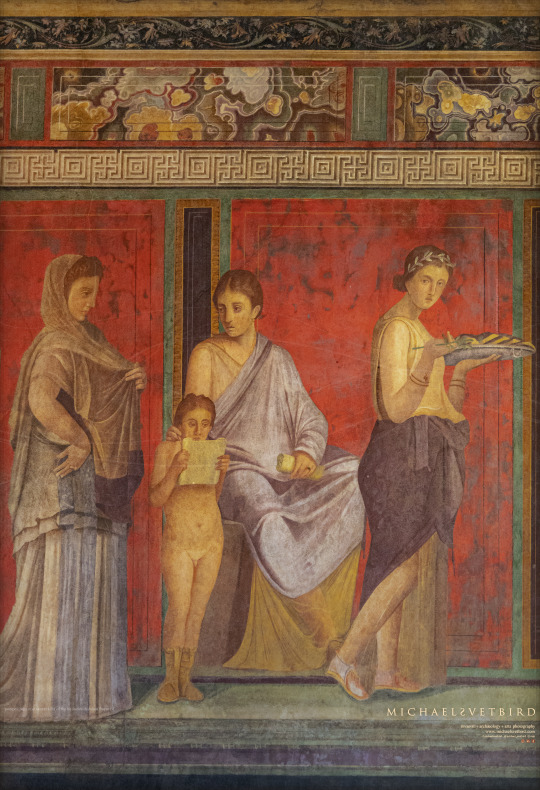
• VILLA DEI MISTERI | Villa of the Mysteries: "The painted frieze, which can be dated to between 70 and 60 BC. is characterized by the representation of large scale mythological figures." [txt ©PAP] Room 5, Main Wall Painting [side-walls are on the way] Villa of the Mysteries, Pompei Scavi, Pompeii, Regio VI http://pompeiisites.org/en/archaeological-site/villa-of-the-mysteries 70-60 BC.
Parco Archeologico di Pompei | PAP http://pompeiisites.org/en FB: https://www.facebook.com/pompeiiparcoarcheologico IG: @ pompeii_parco_archeologico TW: @ pompeii_sites
• Pic 2: - A Maenad, who animated the processions of Dionysus, recoils in fear. - Paniskoi, mythological figures who lived in the woods, suckle a kid and play music.
• Pic 3: - The preparation of a ritual meal for the deity [3 female figs]. - Silenus playing the lyre.
• Pic 4: - The reading the liturgy of the ritual [3 figs w/ a boy]. - A pregnant young woman offers sacred cakes.
• Pics 1 and 5: - General views of the scene [Main wall, Room 5].
PAP | Michael Svetbird phs©msp | 10-11|2022 6200X4100 600 [I.- III. & V.] [no commercial use | sorry for the watermarks]
#pompeii#pompei#pompéi#pompeiscavi#scavi#archaeologicalpark#parcoarcheologico#archaeologicalsite#villaofthemysteries#villadeimisteri#villa#romanvilla#ancientpompeii#pompeiiruins#ancient#ancientpainting#fresco#dionysus#archaeology#ancienthistory#excavations#antiquity#heritage#museology#museum#mythology#photography#museumphotography#archaeologyphotography#michaelsvetbird
30 notes
·
View notes
Text
04.5 – Haircut
*Disclaimer: I am not a hairdresser*
Page-by-Page Notes
Page 1
Val looks at himself in a mirror


(Left) Silver mirror, 1st century CE, silver, https://www.metmuseum.org/art/collection/search/248003.
(Right) Mirror depicted in “Monumental sarcophagus punctuated by niches with a knight in the center”, made in Asia Minor and imported to Rome, Musei Capitolini Centrale Montemartini.
A pair of shears/scissors

A pair of ancient Roman scissors (forfex), c. 201-500 CE, bronze, https://collection.sciencemuseumgroup.org.uk/objects/co86747/ two-pairs-of-ancient-roman-scissors.
Val’s comb is one-sided
Double-sided combs (one side with wider teeth and another finer, more tightly packed side, probably for removing lice)


Comb with case, 1st century CE, boxwood, Vindolanda, Roman Britain, now in the Vindolanda Museum. https://www.vindolanda.com/comb-with-case; https://x.com/OptimoPrincipi/status/1695468752802869520/photo/1.

Small Bone Comb, 1st century CE, bone, Pompeii, Archaeological Park of Pompeii. https://pompeiicommitment.org/en/inventario/body-care-objects/.
Other comb examples:
Bone comb from Pompeii, c. 10-79 CE. https://collection.sciencemuseumgroup.org.uk/objects/co147010/comb-bone-roman-from-pompeii-10-79ad.
Comb, wood, Fayum, Roman Egypt. https://www.britishmuseum.org/collection/object/Y_EA37414

Woman looking in a mirror as she dresses (or undresses) her hair, 1st century CE, fresco, from the Villa of Arianna at Stabiae (Castellammare di Stabia), National Archaeological Museum of Naples. https://www.flickr.com/photos/carolemage/17392924485/.
Val considers selling his leftover locks of hair (blond)
Lucius Verus had golden curly hair, which he sprinkled “gold dust on his head so that his hair might become brighter and blonder” (Grant, 1994)
Records show people lightened their hair color and/or used wigs made from the hair of conquered peoples (e.g., Germany, India) (Ovid, Amores, I.XIV.45-46) (Suetonius, Otho, XII) (Bartman, 2001)
Page 4
Val’s new hairstyle is inspired by Antinous; I intended to keep the anastole (ἀναστολή) hair tuft in the front

Bust of Antinous, 130-138 CE, marble, found at Patras, National Archaeological Museum of Athens, https://en.wikipedia.org/wiki/Bust_of_Antinous_%28NAMA%29.
Clothing/Hairstyles
Tunics and Togas

Fragment of a Fresco Panel with a Meal Preparation, fresco, c. 1st century CE, https://www.getty.edu/art/collection/object/103TPX.

Convito/Banquet scene with inscribed words, 1st century CE, fresco, House of the Triclinium Pompeii (now in Museo Archeologico Nazionale di Napoli), fresco (fourth style), https://isaw.nyu.edu/exhibitions/pompeii-in-color/objects/banquet-scene
Hairstyles (men) (in progress)

Giovane con rotolo, 1st century CE, Pompeii, Museo archeologico nazionale di Napoli. https://commons.wikimedia.org/wiki/File:Giovane_con_rotolo.JPG.
Women’s clothing
(Layers: supparus, tunic, stola, palla)

Fresco of a woman with a tray from the Villa San Marco, Stabia Archaeological Museum, ancient Stabiae, reconstruction by Stephen Chappell, https://commons.wikimedia.org/wiki/File:Fresco_of_a_woman_with_a_tray_from_the_Villa_San_Marco,_ancient_Stabiae.jpg
Reading of the rituals of the bridal mysteries (first fresco), Villa dei Misteri, Pompeii, fresco (second style), c. 60 BCE, https://commons.wikimedia.org/wiki/File:Roman_fresco_Villa_dei_Misteri_Pompeii_001.jpg.
Hairstyles (women)
Nodus
A hairstyle parted in three sections, with one roll of hair over the forehead, and the two remaining sides tied into a bun behind the neck. The style was (re)popularized during the late Republican and Augustan periods by Augustus' wife Livia and Octavia (Stephens, 2013).
Referenced in 03 – Silphium Stealers (ep. 01) when Val and Marina comment on each other’s (informal) hairstyles.
Tutulus
A hairstyle worn primarily by the materfamilias, created using three to four parted sections to create a bun at the top of the head (Olson, 2008) (Stephens, The Tutulus Hairstyle: Ancient Roman Hairdressing, 2013).
Dyes
“A woman will dye her hair with the juice of some German herb; and the artificial colour becomes her better than the natural one.” (Ovid, Ars Amatoria, 3:158-64) (mid-1st century BCE)
“Soap, too, is very useful for this purpose, an invention of the Gauls for giving a reddish tint to the hair. This substance is prepared from tallow and ashes, the best ashes for the purpose being those of the beech and yoke-elm” (Pliny, NH, 28.51) (1st century CE)
“I see some (women) turn (the colour of) their hair with saffron. They are ashamed even of their own nation, (ashamed) that their procreation did not assign them to Germany and to Gaul: thus, as it is, they transfer their hair thither)! Ill, ay, most ill, do they augur for themselves with their flame-coloured head, and think that graceful which (in fact) they are polluting!” (Tertullian, De Culti Feminarum, 2:6:1) (mid-3rd–early 4th c. CE)
Bibliography
Bartman, Elizabeth. “Hair and the Artifice of Roman Female Adornment.” American Journal of Archaeology 105, no. 1 (2001): 1–25. https://doi.org/10.2307/507324.
Grant, Michael. The Antonines: The Roman Empire in Transition. United Kingdom: Routledge, 1994.
Kaufman, David B. “Roman Barbers.” The Classical Weekly 25, no. 19 (1932): 145–48. https://doi.org/10.2307/4339078.
Nicolson, Frank W. “Greek and Roman Barbers.” Harvard Studies in Classical Philology 2 (1891): 41–56. https://doi.org/10.2307/310326.
Olson, Kelly. Dress and the Roman Woman: Self-presentation and Society. United Kingdom: Routledge, 2008.
Radicke, Jan. Roman Women’s Dress: Literary Sources, Terminology, and Historical Development. Berlin, Boston: De Gruyter, 2023. https://doi.org/10.1515/9783110711554
Stephens, Janet. “Ancient Roman Hairdressing: On (Hair)Pins and Needles.” Journal of Roman Archaeology 21 (2008): 110–32. https://doi.org/10.1017/S1047759400004402. Bartman, Elizabeth. “Hair and the Artifice of Roman Female Adornment.” American Journal of Archaeology 105, no. 1 (2001): 1–25. https://doi.org/10.2307/507324.
0 notes
Text

it's said that bikini costume was inspired by Villa dei Misteri
and named after Bikini Atoll, where nuclear trials had taken place - to emphasize impactful nature of the costume
0 notes
Text
Baccanti, satiri, sileni e un corteo di Dioniso: a Pompei emerge una nuova "Villa dei Misteri" decorata con straordinari affreschi [LE FOTO]
🔥🔥🔥 𝐁𝐚𝐜𝐜𝐚n𝐭𝐢, 𝐬𝐚𝐭𝐢𝐫𝐢, 𝐬𝐢𝐥𝐞n𝐢 𝐞 𝐮n 𝐜𝐨𝐫𝐭𝐞𝐨 𝐝𝐢 𝐃𝐢𝐨n𝐢𝐬𝐨: 𝐚 𝐏𝐨𝐦𝐩𝐞𝐢 𝐞𝐦𝐞𝐫𝐠𝐞 𝐮n𝐚 n𝐮𝐨𝐯𝐚 "𝐕𝐢𝐥𝐥𝐚 𝐝𝐞𝐢 𝐌𝐢𝐬𝐭𝐞𝐫𝐢" 𝐝𝐞𝐜𝐨𝐫𝐚𝐭𝐚 𝐜𝐨n 𝐬𝐭𝐫𝐚𝐨𝐫𝐝𝐢n𝐚𝐫𝐢 𝐚𝐟𝐟𝐫𝐞𝐬𝐜𝐡𝐢 A oltre un secolo dalla scoperta della Villa dei Misteri, un altro eccezionale ciclo di affreschi getta luce sui riti di Dioniso. Articolo completo con foto e video su @storieearcheostorie @pompeii_parco_archeologico #archeologia #pompei #scopertearcheologiche
Elena Percivaldi A oltre un secolo dalla scoperta della Villa dei Misteri, un altro eccezionale ciclo di affreschi getta luce sui riti di Dioniso nel mondo classico. Durante gli scavi nell’insula 10 della Regio IX di Pompei, gli archeologi hanno portato alla luce una “megalografia”, ovvero un ciclo di pitture a grandi figure, che decora tre lati di una grande sala per banchetti, con il quarto…
0 notes
Text
Pompei: emerso grande fregio con il corteo di Dioniso
A più di 100 anni di distanza dalla straordinaria scoperta della villa dei Misteri, emerge dagli scavi di Pompei un altro affresco che ha per soggetto il mondo classico. Nella sala dedicata ai banchetti, scavata in queste settimane nell’area dell’insula 10 della Regio IX, è emerso un fregio a dimensioni quasi reali, ovvero una “megalografia”, (dal greco “dipinto grande”- ciclo di pitture a…
0 notes
Text




Gods
paper pulp, smashed stone,
60*125*53 cm,
2023
Villa dei Misteri
The exhibition was commissioned for the 30th anniversary of the Esterházy Private Foundation. 4 October 2024, Etyeki Kúria
Curator: Lili Rebeka Tóth
Photo: Barnabás Neogrády-Kiss
0 notes
Text
Il Museo Archeologico Nazionale di Napoli: viaggio nella storia
Il Museo Archeologico Nazionale di Napoli, meglio conosciuto come MANN, è uno dei musei archeologici più importanti al mondo. Con le sue collezioni vastissime e di inestimabile valore, il MANN offre un viaggio affascinante attraverso la storia e la cultura del Mediterraneo antico. Fondazione e collezioni Fondato nel 1816 da re Ferdinando I di Borbone, il museo riunisce reperti provenienti da diverse aree della Campania, tra cui Pompei, Ercolano, Stabia e la Magna Grecia. La collezione farnesiana, acquisita nel 1734, comprende sculture romane di inestimabile bellezza, come il Toro Farnese e il Fauno Barberini. Il museo ospita anche una ricca collezione egizia, la seconda in Italia per importanza, con mummie, sarcofagi e manufatti di vario genere. I tesori di Pompei ed Ercolano Le città vesuviane sepolte dall'eruzione del 79 d.C. hanno restituito al museo reperti unici che offrono una testimonianza preziosa della vita quotidiana nell'antichità. Affreschi, mosaici, oggetti di uso quotidiano e persino calchi di vittime dell'eruzione ci permettono di rivivere l'atmosfera di queste città romane. Tra i capolavori da non perdere, il Mosaico di Alessandro, la Statua del Fauno Danzante e gli affreschi della Villa dei Misteri. Oltre Pompei: Magna Grecia e Campania Romana Il MANN non si limita alle testimonianze vesuviane. Le sezioni dedicate alla Magna Grecia e alla Campania Romana ospitano reperti di grande valore, come i bronzi di Riace, ritrovati nel mare calabrese nel 1972, e la Coppa di Nestore, un vaso attico del VI secolo a.C. decorato con scene della guerra di Troia. Museo Archeologico Nazionale di Napoli: un'esperienza immersa nella storia Il Museo Archeologico Nazionale di Napoli non è solo un deposito di reperti archeologici, ma un luogo di conoscenza e di cultura. Grazie a percorsi di visita tematici, mostre temporanee e laboratori didattici, il museo offre al pubblico un'esperienza immersiva nella storia del Mediterraneo antico. Immagine di copertina: DepositPhotos Read the full article
0 notes
Text
La villa dei misteri. Abusi sessuali, l’inchiesta: blitz della Scientifica nella casa del prete
Pesaro, 17 aprile 2024 – La villa dei misteri. E’ giallo intorno all’abitazione di un sacerdote originario di Sant’Angelo in Vado, nel Pesarese, ma residente in Svizzera. La polizia scientifica, sabato scorso, ha sigillato l’immobile sottoposto a sequestro penale per ordine della procura di Urbino. Otto agenti della polizia scientifica da Ancona sono arrivati intorno alle 11 nella villa di via…
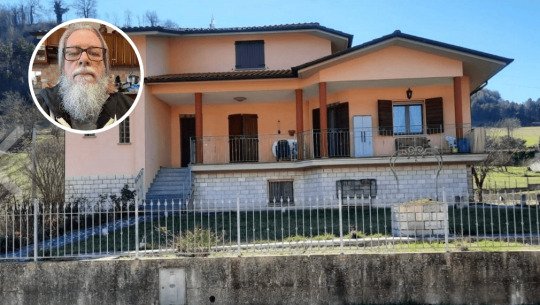
View On WordPress
0 notes
